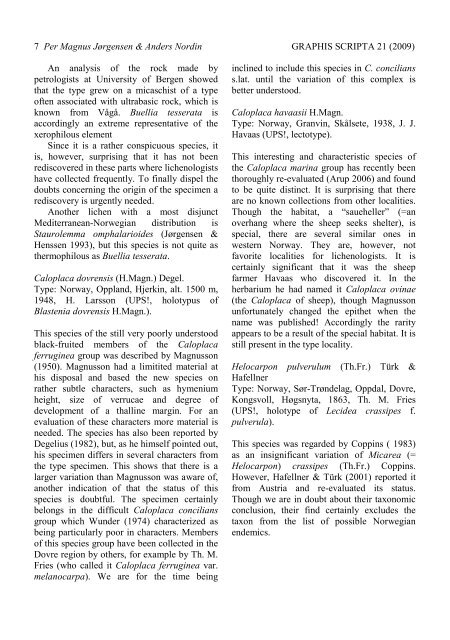(2009): Lichens in Scandinavia known mainly from Norwegian type ...
(2009): Lichens in Scandinavia known mainly from Norwegian type ...
(2009): Lichens in Scandinavia known mainly from Norwegian type ...
You also want an ePaper? Increase the reach of your titles
YUMPU automatically turns print PDFs into web optimized ePapers that Google loves.
7 Per Magnus Jørgensen & Anders Nord<strong>in</strong> GRAPHIS SCRIPTA 21 (<strong>2009</strong>)<br />
An analysis of the rock made by<br />
petrologists at University of Bergen showed<br />
that the <strong>type</strong> grew on a micaschist of a <strong>type</strong><br />
often associated with ultrabasic rock, which is<br />
<strong>known</strong> <strong>from</strong> Vågå. Buellia tesserata is<br />
accord<strong>in</strong>gly an extreme representative of the<br />
xerophilous element<br />
S<strong>in</strong>ce it is a rather conspicuous species, it<br />
is, however, surpris<strong>in</strong>g that it has not been<br />
rediscovered <strong>in</strong> these parts where lichenologists<br />
have collected frequently. To f<strong>in</strong>ally dispel the<br />
doubts concern<strong>in</strong>g the orig<strong>in</strong> of the specimen a<br />
rediscovery is urgently needed.<br />
Another lichen with a most disjunct<br />
Mediterranean-<strong>Norwegian</strong> distribution is<br />
Staurolemma omphalarioides (Jørgensen &<br />
Henssen 1993), but this species is not quite as<br />
thermophilous as Buellia tesserata.<br />
Caloplaca dovrensis (H.Magn.) Degel.<br />
Type: Norway, Oppland, Hjerk<strong>in</strong>, alt. 1500 m,<br />
1948, H. Larsson (UPS!, holotypus of<br />
Blastenia dovrensis H.Magn.).<br />
This species of the still very poorly understood<br />
black-fruited members of the Caloplaca<br />
ferrug<strong>in</strong>ea group was described by Magnusson<br />
(1950). Magnusson had a limitited material at<br />
his disposal and based the new species on<br />
rather subtle characters, such as hymenium<br />
height, size of verrucae and degree of<br />
development of a thall<strong>in</strong>e marg<strong>in</strong>. For an<br />
evaluation of these characters more material is<br />
needed. The species has also been reported by<br />
Degelius (1982), but, as he himself po<strong>in</strong>ted out,<br />
his specimen differs <strong>in</strong> several characters <strong>from</strong><br />
the <strong>type</strong> specimen. This shows that there is a<br />
larger variation than Magnusson was aware of,<br />
another <strong>in</strong>dication of that the status of this<br />
species is doubtful. The specimen certa<strong>in</strong>ly<br />
belongs <strong>in</strong> the difficult Caloplaca concilians<br />
group which Wunder (1974) characterized as<br />
be<strong>in</strong>g particularly poor <strong>in</strong> characters. Members<br />
of this species group have been collected <strong>in</strong> the<br />
Dovre region by others, for example by Th. M.<br />
Fries (who called it Caloplaca ferrug<strong>in</strong>ea var.<br />
melanocarpa). We are for the time be<strong>in</strong>g<br />
<strong>in</strong>cl<strong>in</strong>ed to <strong>in</strong>clude this species <strong>in</strong> C. concilians<br />
s.lat. until the variation of this complex is<br />
better understood.<br />
Caloplaca havaasii H.Magn.<br />
Type: Norway, Granv<strong>in</strong>, Skålsete, 1938, J. J.<br />
Havaas (UPS!, lecto<strong>type</strong>).<br />
This <strong>in</strong>terest<strong>in</strong>g and characteristic species of<br />
the Caloplaca mar<strong>in</strong>a group has recently been<br />
thoroughly re-evaluated (Arup 2006) and found<br />
to be quite dist<strong>in</strong>ct. It is surpris<strong>in</strong>g that there<br />
are no <strong>known</strong> collections <strong>from</strong> other localities.<br />
Though the habitat, a “saueheller” (=an<br />
overhang where the sheep seeks shelter), is<br />
special, there are several similar ones <strong>in</strong><br />
western Norway. They are, however, not<br />
favorite localities for lichenologists. It is<br />
certa<strong>in</strong>ly significant that it was the sheep<br />
farmer Havaas who discovered it. In the<br />
herbarium he had named it Caloplaca ov<strong>in</strong>ae<br />
(the Caloplaca of sheep), though Magnusson<br />
unfortunately changed the epithet when the<br />
name was published! Accord<strong>in</strong>gly the rarity<br />
appears to be a result of the special habitat. It is<br />
still present <strong>in</strong> the <strong>type</strong> locality.<br />
Helocarpon pulverulum (Th.Fr.) Türk &<br />
Hafellner<br />
Type: Norway, Sør-Trøndelag, Oppdal, Dovre,<br />
Kongsvoll, Høgsnyta, 1863, Th. M. Fries<br />
(UPS!, holo<strong>type</strong> of Lecidea crassipes f.<br />
pulverula).<br />
This species was regarded by Copp<strong>in</strong>s ( 1983)<br />
as an <strong>in</strong>significant variation of Micarea (=<br />
Helocarpon) crassipes (Th.Fr.) Copp<strong>in</strong>s.<br />
However, Hafellner & Türk (2001) reported it<br />
<strong>from</strong> Austria and re-evaluated its status.<br />
Though we are <strong>in</strong> doubt about their taxonomic<br />
conclusion, their f<strong>in</strong>d certa<strong>in</strong>ly excludes the<br />
taxon <strong>from</strong> the list of possible <strong>Norwegian</strong><br />
endemics.

















